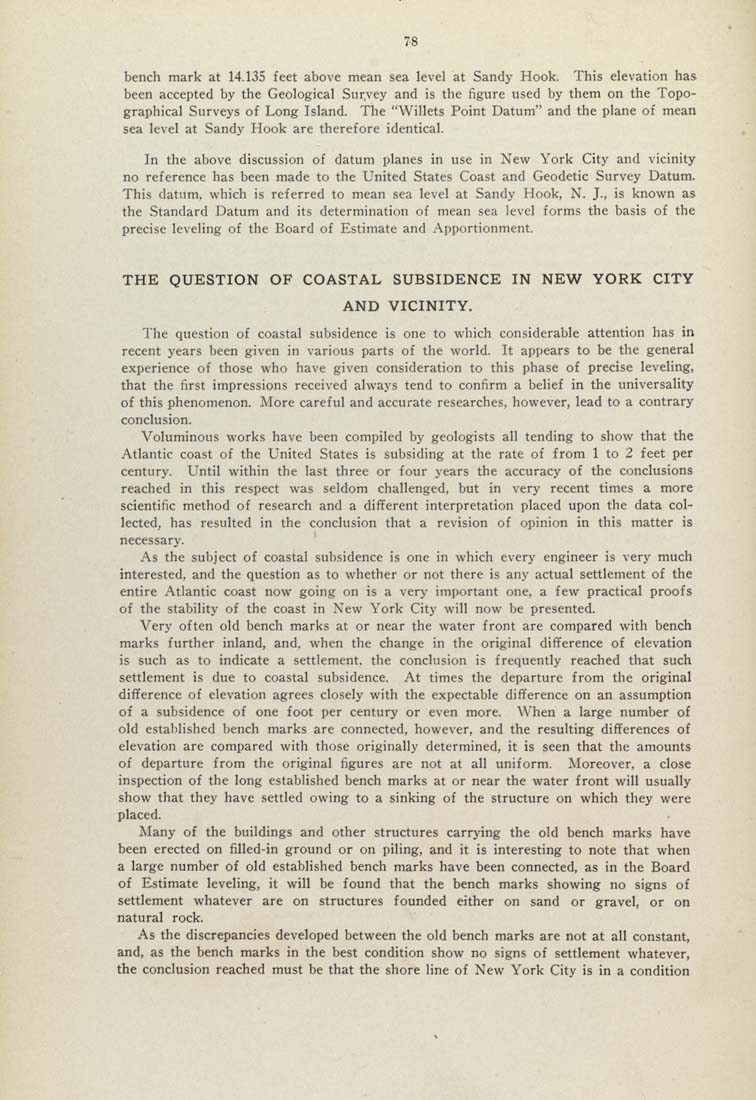78
bench mark at 14.135 feet above mean sea level at Sandy Hook. This elevation has
been accepted by the Geological Sur.vey and is the figure used by them on the Topo¬
graphical Surveys of Long Island. The "Willets Point Datum" and the plane of mean
sea level at Sandy Hook are therefore identical.
In the above discussion of datum planes in use In New York City and vicinity
no reference has been made to the United States Coast and Geodetic Survey Datum.
This datum, which is referred to mean sea level at Sandy Hook, N. J,, is known as
the Standard Datum and its determination of mean sea level forms the basis of the
precise leveling of the Board of Estimate and .Apportionment,
THE QUESTION OF COASTAL SUBSIDENCE IN NEW YORK CITY
AND VICINITY.
The question of coastal subsidence is one to which considerable attention has in
recent years been given in various parts of the world. It appears to be the general
experience of those who have given consideration to this phase of precise leveling,
that the first impressions received always tend to confirm a belief in the universality
of this phenomenon. More careful and accurate researches, however, lead to a contrary
conclusion.
Voluminous works have been compiled by geologists all tending to show that the
Atlantic coast of the United States is subsiding at the rate of from 1 to 2 feet per
century. Until within the last three or four years the accuracy of the conclusions
reached in this respect was seldom challenged, but in very recent times a more
scientific method of research and a different interpretation placed upon the data col¬
lected, has resulted in the conclusion that a revision of opinion in this matter is
necessary.
As the subject of coastal subsidence is one in which every engineer is very much
interested, and the question as to whether or not there is any actual settlement of the
entire Atlantic coast now going on is a very important one, a few practical proofs
of the stability of the coast in New York City will now be presented.
Very often old bench marks at or near the water front are compared with bench
marks further inland, and, when the change in the original difference of elevation
is such as to indicate a settlement, the conclusion is frequently reached that such
settlement is due to coastal subsidence. At times the departure from the original
difference of elevation agrees closely with the expectable difference on an assumption
of a subsidence of one foot per century or even more. When a large number of
old established bench marks are connected, however, and the resulting differences of
elevation are compared with those originally determined, it is seen that the amounts
of departure from the original figures are not at all uniform. Moreover, a close
inspection of the long established bench marks at or near the water front will usually
show that they have settled owing to a sinking of the structure on which they were
placed.
Many of the buildings and other structures carrying the old bench marks have
been erected on filled-in ground or on piling, and it is interesting to note that when
a large number of old established bench marks have been connected, as in the Board
of Estimate leveling, it will be found that the bench marks showing no signs of
settlement whatever are on structures founded either on sand or gravel, or on
natural rock.
As the discrepancies developed between the old bench marks are not at all constant,
and, as the bench marks in the best condition show no signs of settlement whatever,
the conclusion reached must be that the shore line of New York City is in a condition
|








